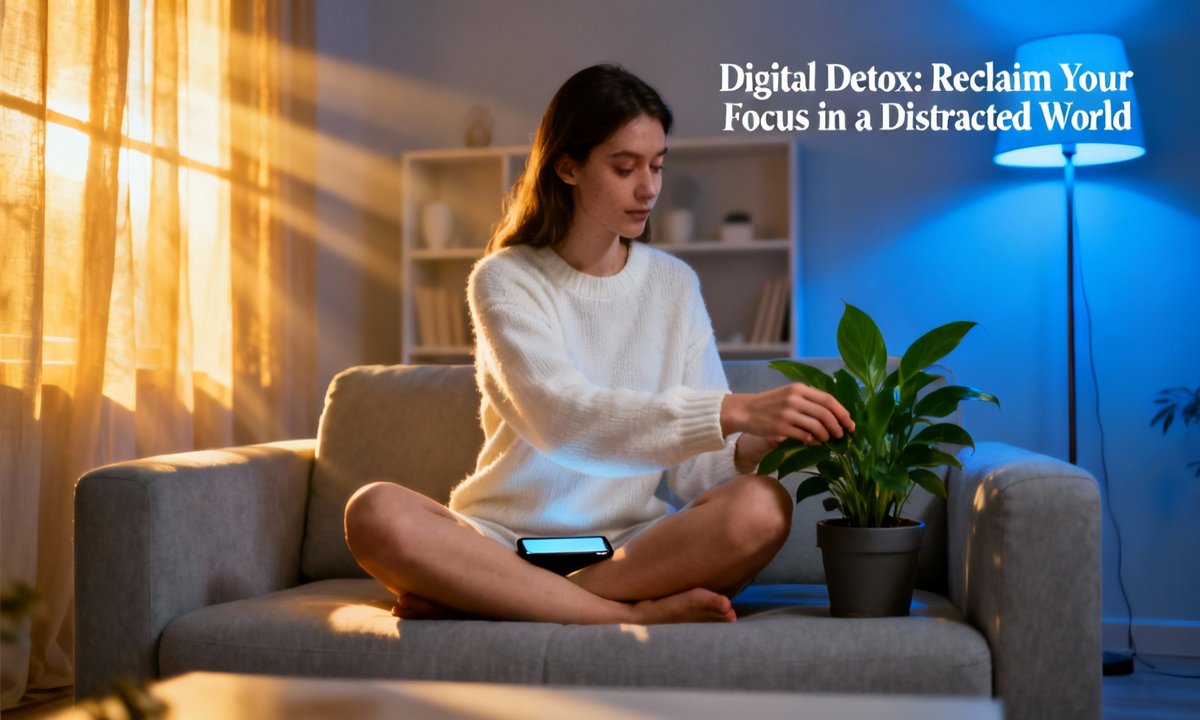Have you ever caught yourself endlessly scrolling through your phone, only to realize a significant amount of time has passed? Many people share this experience. In our constantly connected world, a digital detox might be exactly what you need to regain your focus and enhance mental well-being. Discover why disconnecting is crucial and how you can use mindful technology to control your attention in our digital age.
Understanding a Digital Detox
A digital detox is a purposeful break from electronic devices such as phones, computers, and tablets. Its aim is to reduce screen time, boost concentration, and help you reconnect with the real world. It’s about setting healthy digital boundaries, not abandoning technology entirely.
Even short detoxes, like screen-free hours, can positively affect your well-being and mental focus. To learn more about fostering balanced technology use, explore resources on mindful technology. Learn more about mindful technology use.
The Modern Need for Digital Detox
Today, hyper-connectivity brings significant challenges despite its benefits. A notable 64% of teens report sleep deprivation linked to late-night device use. Furthermore, increased technology engagement is associated with rising rates of depression and anxiety across all age groups. See more statistics here.
The digital world’s design, with constant notifications and endless feeds, aims to keep us engaged. This constant digital pull can easily lead to distraction and overwhelm, making it difficult to truly focus on important tasks or moments.
A digital detox isn’t about rejecting technology; it’s about restoring your attention and emotional equilibrium. It helps you navigate a world full of alerts and updates with greater calm and control.
Understanding the Impact of Screen Time
Setting mindful technology boundaries can lead to improved sleep quality, more meaningful face-to-face interactions, and better overall mental health. For a comprehensive exploration of these benefits and strategies, refer to our guide on mindful technology use. Explore mindful technology use.
Research consistently shows a strong connection between excessive screen time and mental health concerns. For instance, social media users often report higher instances of depression. Also, roughly one-third of individuals experience physical discomfort, like thumb or wrist pain, from device overuse. Access further research findings.
Studies also indicate that simply limiting social media to 30 minutes daily for two weeks can significantly improve sleep patterns and reduce overall smartphone use. This demonstrates the tangible positive effects of even minor digital adjustments on well-being. Review related research.
Recognizing When a Digital Detox is Needed
Understanding your personal relationship with technology marks the crucial first step. Consider if a digital detox could be beneficial for you if you often feel uneasy or irritable when separated from your phone, or find hours disappearing due to aimless scrolling.
Other indicators include difficulty focusing, struggling with sleep, or having trouble completing tasks. Frequently checking notifications, even during busy moments, or observing a decline in face-to-face social skills also suggest a need for change.
It’s easy to underestimate the impact of unchecked device use. If these signs resonate with your experience, consider a tailored detox challenge. Specialized tools and resources are available to help you gently break unhealthy digital habits. Explore apps for digital detox.
Practical Steps to Minimize Digital Distraction
Create Tech-Free Spaces
Designate specific areas in your home, such as your bedroom or dining room, as screen-free zones. Removing devices during meals or before bedtime can significantly reduce digital interference, fostering more mindful daily routines.
Some employers are even exploring tech-free zones to enhance workplace concentration and productivity. See relevant research findings.
Manage Your Notifications
Consider disabling non-essential notifications or activating ‘Do Not Disturb’ modes on your devices. This simple action can cultivate a much calmer personal environment, diminishing the constant urge to check for updates.
Experts suggest beginning with one platform, like email or social media, and gradually expanding this practice to other apps for broader effect. Review expert recommendations.
Embrace Shorter Detox Periods
A digital break doesn’t always require prolonged disconnection. Experiment with short, focused offline breaks, such as 60 minutes each day, or implement ‘phone-free Fridays.’ These mini-detoxes can help recalibrate your brain’s ability to focus. Explore beneficial apps for digital detox.
Keep Devices Out of the Bedroom
Relocating your phone charger outside the bedroom can profoundly improve sleep quality and set a more positive tone for your mornings. A significant percentage of adolescents struggle with sleep due to nighttime device use, and adults can benefit equally from device-free evenings. View related sleep statistics.
Self-Assessment: Is it Time for a Digital Detox?
Consider these questions to gauge your current digital habits:
- Do you check your phone within five minutes of waking up?
- Do you feel anxious or uneasy when offline?
- Are screens typically present during your meals?
- Have you recently experienced eye strain or wrist discomfort?
If you answered yes to two or more, a dedicated digital detox could notably boost your productivity and mental clarity.
Enriching Your Life with Offline Activities
Viewing a digital detox as an opportunity, rather than a restriction, can transform your perspective. Filling your free time with purposeful offline activities can deeply rejuvenate your mind and body. There are numerous ways to engage in well-being practices away from screens. Explore more offline activities for well-being.
Consider taking invigorating nature walks or hiking in a nearby park. You might also explore creative hobbies like journaling or painting, allowing for self-expression and mental engagement. Preparing a nourishing meal can also be a mindful and rewarding experience. Browse vegan recipes for inspiration.
Engaging in mindfulness techniques, such as meditation or focused breathing exercises, can calm your thoughts. Another wonderful option is to host a device-free game night, fostering genuine connection with friends or family without digital interruptions.
Being fully present in these moments helps to replenish your energy and strengthen real-world connections. As you declutter your mind through these activities, you might also consider decluttering your physical environment. Discover our seasonal refresh and cleaning guide.
Cultivating Sustainable Digital Habits
Establishing and maintaining new, healthier habits becomes much simpler with effective strategies. Key elements for success include creating a supportive structure and finding reliable support systems to keep you on track.
Begin by identifying your most challenging digital habits, which often involve social media or streaming content. Partnering with a friend for mutual accountability can provide significant motivation. Tracking your progress, whether with a simple analog notebook or a dedicated detox challenge app, is also highly effective.
Personalized methods often yield the best results. For example, Millennials frequently embark on digital detoxes, often choosing incremental changes like deleting specific apps or setting strict screen-time limits. Learn about digital detox trends.
A Simple Progress Tracker
To help you visualize your journey, consider tracking your daily achievements. Mark each day you successfully:
- Stay within your set screen-time goal
- Dedicate at least one hour to an engaging offline hobby
- Avoid checking emails or social media before breakfast
Share your inspiring progress using the hashtag #ReclaimYourFocus to encourage others on their paths.
Transformative Benefits of a Digital Detox
Regular engagement in a digital detox offers a wealth of significant advantages for your overall well-being. These consistent efforts can lead to noticeable reductions in feelings of anxiety and stress, promoting a calmer state of mind. Read a related study.
You can also expect improved sleep quality, fostering better rest and increased energy. Furthermore, a detox helps cultivate greater self-control and emotional regulation, allowing for more thoughtful responses to daily life. It also enhances face-to-face social connections and boosts both productivity and creativity.
Achieving lasting change often requires consistent effort and a willingness to try different strategies. While temporary improvements are common, the most profound and long-term benefits emerge through sustained dedication and mindful practice. Understand the nuances of sustained change.
Common Questions About Digital Detox and Focus
What exactly is a digital detox?
A digital detox involves taking a deliberate break from electronic devices. The core purpose is to minimize screen time, rejuvenate your focus, and enhance your overall mental well-being and health.
Who might benefit from a digital detox?
Anyone experiencing distraction, anxiety, or a lack of focus due to technology could benefit. This is particularly relevant for frequent social media users and individuals seeking a better work-life balance away from constant digital demands.
What is the recommended duration for a digital detox?
Even brief daily breaks can be effective. However, many individuals find greater benefit from regularly scheduled longer periods, such as screen-free hours, entire weekends, or even weeks without social media engagement.
Are there any potential drawbacks or risks?
Some individuals initially report feelings of social isolation or FOMO (fear of missing out). However, these sensations typically diminish as positive new habits are established. Implementing a structured approach and seeking social support can significantly ease this transition. Review relevant findings.
Valuable Resources for Mindful Technology Use
For further guidance and practical tools, explore these insightful resources designed to support your journey toward healthier digital habits:
- Mindful Technology Use: Discover actionable tips and strategies for healthier daily routines.
- Best Apps for Reducing Screen Time: Access useful tools to effectively manage and monitor your device usage.
- Offline Activities for Well-being: Find creative and fulfilling ways to disconnect and reconnect with yourself.
- Scientific Research on Technology Addiction: Delve into studies and statistics regarding digital dependency (opens in new tab).
- Expert Guidance on Digital Wellness: Gain insights from specialists on maintaining digital balance (opens in new tab).
Reflect, Reset, and Reclaim Your Focus
Embracing a digital detox is a deeply personal journey, and even minor adjustments today can lead to significant, lasting improvements in your well-being, focus, and creativity. Consider dedicating a night to being tech-free or exploring a favorite offline activity to start. Explore a favorite offline activity.
You might also join a detox challenge for added motivation and support. Remember, the core idea isn’t about rejecting technology outright; it’s about reasserting control and finding a balanced approach to digital engagement on your own terms.
Feeling motivated to make a change? Share your progress and inspire others by using the hashtag #ReclaimYourFocus. Together, we can build healthier digital lives and collectively reclaim what truly matters most in our increasingly connected world.
References and expert commentary are thoughtfully integrated throughout this guide. For a printable checklist or additional support, refer to our comprehensive Mindful Technology Use resource.



